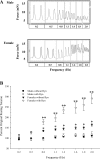Dichloroacetate selectively improves cardiac function and metabolism in female and male rainbow trout
- PMID: 25217653
- PMCID: PMC4233302
- DOI: 10.1152/ajpheart.00755.2013
Dichloroacetate selectively improves cardiac function and metabolism in female and male rainbow trout
Abstract
Cardiac tissue from female rainbow trout demonstrates a sex-specific preference for exogenous glucose and glycolysis, impaired Ca(2+) handling, and a greater tolerance for hypoxia and reoxygenation than cardiac tissue from male rainbow trout. We tested the hypothesis that dichloroacetate (DCA), an activator of pyruvate dehydrogenase, enhances cardiac energy metabolism and Ca(2+) handling in female preparations and provide cardioprotection for hypoxic male tissue. Ventricle strips from sexually immature fish with very low (male) and nondetectable (female) plasma sex steroids were electrically paced in oxygenated or hypoxic Ringer solution with or without 1 mM DCA. In the presence of 5 mM glucose, aerobic tissue from male trout could be paced at a higher frequency (1.79 vs. 1.36 Hz) with lower resting tension and less contractile dysfunction than female tissue. At 0.5 Hz, DCA selectively reduced resting tension below baseline values and lactate efflux by 75% in aerobic female ventricle strips. DCA improved the functional recovery of developed twitch force, reduced lactate efflux by 50%, and doubled citrate in male preparations after hypoxia-reoxygenation. Independent of female sex steroids, reduced myocardial pyruvate dehydrogenase activity and impaired carbohydrate oxidation might explain the higher lactate efflux, compromised function of the sarcoplasmic reticulum, and reduced mechanical performance of aerobic female tissue. Elevated oxidative metabolism and reduced glycolysis might also underlie the beneficial effects of DCA on the mechanical recovery of male cardiac tissue after hypoxia-reoxygenation. These results support the use of rainbow trout as an experimental model of sex differences of cardiovascular energetics and function, with the potential for modifying metabolic phenotypes and cardioprotection independent of sex steroids.
Keywords: cardiac; dichloroacetate; glucose; hypoxia; lactate; rainbow trout; sex differences.
Copyright © 2014 the American Physiological Society.
Figures




Similar articles
-
Sex differences in energy metabolism and performance of teleost cardiac tissue.Am J Physiol Regul Integr Comp Physiol. 2007 Feb;292(2):R827-36. doi: 10.1152/ajpregu.00379.2006. Epub 2006 Oct 12. Am J Physiol Regul Integr Comp Physiol. 2007. PMID: 17038442
-
Steroid-induced cardiac contractility requires exogenous glucose, glycolysis and the sarcoplasmic reticulum in rainbow trout.J Exp Biol. 2006 Jun;209(Pt 11):2114-28. doi: 10.1242/jeb.02241. J Exp Biol. 2006. PMID: 16709913
-
Limited effects of exogenous glucose during severe hypoxia and a lack of hypoxia-stimulated glucose uptake in isolated rainbow trout cardiac muscle.J Exp Biol. 2013 Sep 15;216(Pt 18):3422-32. doi: 10.1242/jeb.085688. Epub 2013 May 16. J Exp Biol. 2013. PMID: 23685969 Free PMC article.
-
Feeding the fibrillating heart: Dichloroacetate improves cardiac contractile dysfunction following VF.Am J Physiol Heart Circ Physiol. 2015 Nov;309(9):H1543-53. doi: 10.1152/ajpheart.00404.2015. Epub 2015 Sep 4. Am J Physiol Heart Circ Physiol. 2015. PMID: 26342067 Free PMC article.
-
Effect and mechanism of Dichloroacetate in the treatment of stroke and the resolution strategy for side effect.Eur J Med Res. 2025 Mar 3;30(1):148. doi: 10.1186/s40001-025-02399-5. Eur J Med Res. 2025. PMID: 40025562 Free PMC article. Review.
Cited by
-
Role of the Pyruvate Dehydrogenase Complex in Metabolic Remodeling: Differential Pyruvate Dehydrogenase Complex Functions in Metabolism.Diabetes Metab J. 2018 Aug;42(4):270-281. doi: 10.4093/dmj.2018.0101. Diabetes Metab J. 2018. PMID: 30136450 Free PMC article. Review.
-
Dioxygen and Metabolism; Dangerous Liaisons in Cardiac Function and Disease.Front Physiol. 2017 Dec 12;8:1044. doi: 10.3389/fphys.2017.01044. eCollection 2017. Front Physiol. 2017. PMID: 29311974 Free PMC article. Review.
References
-
- Aho E, Vornanen M. Contractile properties of atrial and ventricular myocardium of the heart of rainbow Oncorhynchus mykiss: effects of thermal acclimation. J Exp Biol 202: 2663–2677, 1999. - PubMed
-
- Alves MG, Oliveira PJ, Carvalho RA. Substrate selection in hearts subjected to ischemia/reperfusion: role of cardioplegic solutions and gender. NMR Biomed 24: 1029–1037, 2011. - PubMed
-
- Apstein CS, Deckelbaum L, Hagopian L, Hood WB. Acute cardiac ischemia and reperfusion–contractility, relaxation, and glycolysis. Am J Physiol Heart Circ Physiol 235: H636–H648, 1978. - PubMed
-
- Arthur PG, Keen JE, Hochachka PW, Farrell AP. Metabolic state of the in situ perfused trout heart during severe hypoxia. Am J Physiol Regul Integr Comp Physiol 263: R798–R804, 1992. - PubMed
Publication types
MeSH terms
Substances
Grants and funding
LinkOut - more resources
Full Text Sources
Other Literature Sources
Miscellaneous

